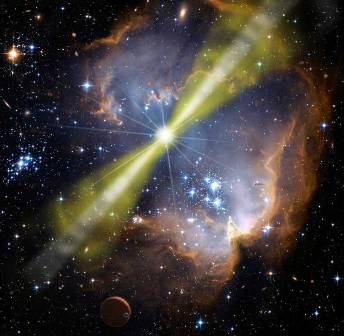Astronomers spot most distant object in the Universe
 London, April 28 : Astronomers have spotted the most distant object yet confirmed in the universe, which is a self-destructing star that exploded 13.1 billion light years from Earth.
London, April 28 : Astronomers have spotted the most distant object yet confirmed in the universe, which is a self-destructing star that exploded 13.1 billion light years from Earth.
According to a report in New Scientist, it detonated just 640 million years after the big bang, around the end of the cosmic "dark ages", when the first stars and galaxies were lighting up space.
The object is a gamma-ray burst (GRB) - the brightest type of stellar explosion.
GRBs occur when massive, spinning stars collapse to form black holes and spew out jets of gas at nearly the speed of light.
These jets send gamma rays our way, along with "afterglows" at other wavelengths, which are produced when the jet heats up surrounding gas.
The burst, dubbed GRB 090423 for the date of its discovery on April 23, was originally spotted by NASA's Swift satellite at 0755 GMT.
Within an hour, astronomers began training ground-based telescopes on the same patch of sky to study the burst's infrared afterglow.
Some of the first observations were made on Mauna Kea in Hawaii with the United Kingdom Infrared Telescope and the Gemini North telescope.
Other telescopes later measured the spectrum of the afterglow, revealing that the burst detonated about 13.1 billion light years from Earth.
"It's the most distance gamma-ray burst, but it's also the most distant object in the universe overall," said Edo Berger of the Harvard-Smithsonian Center for Astrophysics, a member of the team that observed the afterglow with Gemini North.
This burst lies at a redshift of 8.2, more distant than the previous GRB record holder, which lay at a redshift of 6.7.
Other astronomers have claimed to find galaxies at even greater distances - at redshifts of 10 and 9, but those findings are still ambiguous, according to Joshua Bloom of the University of California, Berkeley, who observed the afterglow using the Gemini South telescope in Chile.
Until now, the record holder for the farthest galaxy had a spectroscopically confirmed redshift of 6.96.
The burst's immense distance makes the now-dead star the earliest object to be discovered from an era called `reionisation', which occurred within the first billion years after the big bang.
At that time, an obscuring fog of neutral hydrogen atoms was being burned off by radiation from the first stars and galaxies, and possibly also from the annihilation of dark matter particles.
"For astronomy, this is a watershed event," Bloom told New Scientist. "This is the beginning of the study of the universe as it was before most of the structure that we know about today came into being," he added. (ANI)